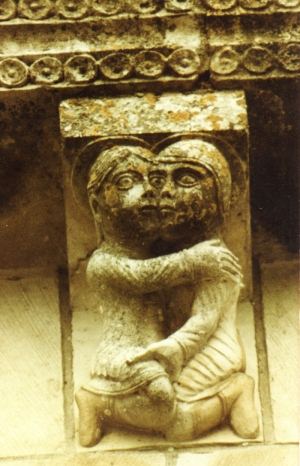The Unmentionable Vice

I’m curling up with a good book by the fireplace this Christmas: The Unmentionable Vice: Homosexuality in the Later Medieval Period. Written by Michael Goodich, the book was published in 1979.
I have often wondered why and when the church began to focus on sodomy as a sin so detestable it crystallized in the phrase “peccatum mutum” – the mute sin, the silent sin- the secret sin. What combination of people and events came together to ignite a centuries-long persecution of homosexuals by the church? Why did it start? What incident, situation, person or persons was the catalyst for the continuing cascade of religious persecution that began in the 11th century?
Three other books dealing with medieval gay history are also on my list to read: John E. Boswell’s two books – Christianity, Social Tolerance, and Homosexuality: Gay People in Western Christianity From the Beginning of the Christian Era to the Fourteenth Century (1980); Same-Sex Unions in Premodern Europe (1995); and Sodomy, Masculinity and Law in Medieval Literature: France and England, 1050-1230 (2004) by William Burgwinkle.
One major aim of his work, Dr. Boswell wrote, was “to rebut the common idea that religious belief–Christian or other–has been the cause of intolerance in regard to gay people.”
Dr. Goodich seems to have drawn the opposite conclusion.
In two 1976 articles in the Journal of Homosexuality, Michael Goodich briefly sketched the close connection between heresy and sodomy in 13th century secular and ecclesiastical law. His book, The Unmentionable Vice, elaborated that sketch into a full-scale study of homosexuality in Europe from the 11th to the early 14th century. Goodich posits it is during this period the Catholic Church consolidated its moral condemnation of homosexual activity.
Although the Council of Ancyra had treated sodomy as a crime as early as 314 A.D., at the beginning of the 11th century there was no uniform legislation on the subject. It seems to be been regarded primarily as a non-Christian vice.
But thereafter more and more attention was given to sexual conformity. Two treatises devoted to the denunciation of homosexuality, Peter Damian’s Book of Gomorrah (1049) and Alan of Lille’s Complaint of Nature (ca 1165) were published during this period.
With the opening of the Fourth Latern Council (1215), “a more miltant, aggressive phase opened in the history of the Catholic Church,” Goodich writes. The penalities for conviction of sodomy continued to be strengthened, and the Inquisition was developed as a means of hunting down heretics and sodomites. The Domincian Order was to take an instrumental role in exterminating heresy and hunting down that “evil filth” (sodomites).
Although he was an Italian Renaissance figure, in the 1490s Dominican Girolamo Savonarola of Florence succeeded in declaring sodomy a capital offense punishable by death.
One of the interesting parts of Goodich’s book is the verbatim report of the trial for heresy and sodomy of Arnold of Verniolle in 1323. The distance between theoretical views and actual practice (sound familiar!) is shown by the apparent ease with which he met his partners.
By his own confession, Arnold committed sodomy with several young men, whose testimony is also included. Arnold was eventually sentenced to life imprisonment in chains, on a diet of bread and water.
What happened to him?

December 19th, 2008 at 3:22 pm
Thank you for this. I am familiar with Boswell’s two books, which as you know have had had a major impact. After reading these, you might like to look at “The Boswell Thesis”, (ed. Mathew Kuefler)which was published to mark the 25th anniversary of “Christianity, Social Tolerance, and Homosexuality.”
I have not yet come across the other two you mention, but will most certainly be adding them to my reading list.
December 20th, 2008 at 7:16 pm
Terry, thank you for the suggestion. I would be interesting in knowing your thoughts or theory on why the church began to condemn sodomy so harshly in medieval times. All the best to you. Merry Christmas!
December 23rd, 2008 at 4:47 am
Thanks for responding. Feel free to use my email address if you like.
(weldon.terry@googlemail.com) I would add that I find your site generally impressive. I have a look at it 2/3 time a week, and will most certainly be adding a link to my own blog, which I am now preparing – I hope to have a preview version up for New Year. Let me know if you would like to have a look at it.
Back to church history: I don’t think it was so much a case of ‘beginning’ the condemnation in the medieval period, as of stepping it up, so that the discourse became dominant. (Paradoxically, there also seems to have been a ‘gay’ cultural flowering during the high middle ages.) Boswell spells out the progression in great detail. Mark Jordan “The Invention of Sodomy” is also helpful.
My understanding, though, is that Peter Damian’s influence, and Acquinas’ development of the argument from Natural Law, were crucial. This is why Michael Bayley’s series on Modern, progressive perspectives on Natural Law could be important.
December 24th, 2008 at 8:09 am
Terry, I would love to have look at your blog. I would be honored. Thank you. Thank you again for suggesting other books and resources re: medieval gay/church history. I wish I could be a scholar in this area, but since I never studied and don’t read Latin it’s not a possibility. However, I hope to be a good amateur sleuth!